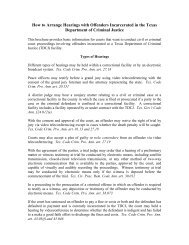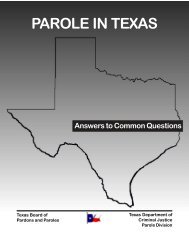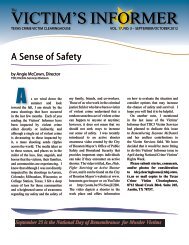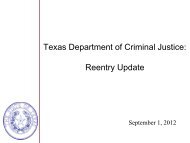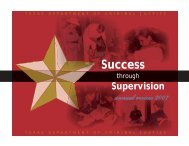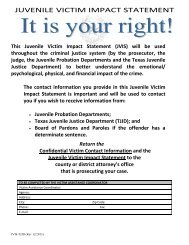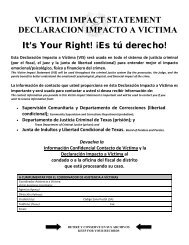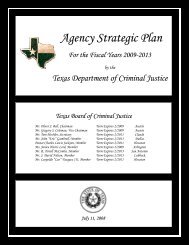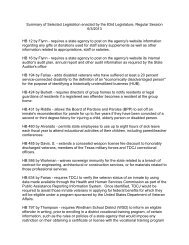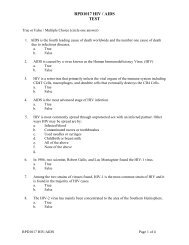TDCJ-CJAD Data Manual - Texas Department of Criminal Justice
TDCJ-CJAD Data Manual - Texas Department of Criminal Justice
TDCJ-CJAD Data Manual - Texas Department of Criminal Justice
Create successful ePaper yourself
Turn your PDF publications into a flip-book with our unique Google optimized e-Paper software.
Appendix B: Program CodesNon-Residential Codes (Cont.)NEDPSCTPTRNon-academic Education Program: A program that only provides non-academic education courses and/orclasses. That is, programs that do not emphasize academic skills acquisition, but rather have a specificshorter-term training goal. This category should be used to report programs that provide life skills classes,parenting classes, financial management classes, vocational/technical education, and other non-academicactivities (i.e., HIV/AIDS education) designed to teach and inform participants <strong>of</strong> various issues. Pleasenote: Education services that are designed to raise the academic level <strong>of</strong> the participant should not beincluded in this category.Progressive Sanctions Court: An intervention strategy involving regular judicial review and monitoring <strong>of</strong><strong>of</strong>fender compliance to community supervision with appropriate, timely and consistent use <strong>of</strong> sanctions andincentives.Pretrial Services: Any program that provides programs or supervision services to an individual chargedwith a criminal <strong>of</strong>fense at the pre-adjudication level (does not include <strong>of</strong>fenders on deferred adjudicationcommunity supervision).PTRM Pretrial, Mentally Impaired/DD/MR: Pretrial Services Program as described above with a targetpopulation <strong>of</strong> Mentally Impaired, Developmentally Disabled and/or Mentally Retarded.SAESATSOPSXCVSVSubstance Abuse Education: Programs designed to inform <strong>of</strong>fenders about the physical, psychological,emotional, and social consequences <strong>of</strong> alcohol and drug use. Common examples include DWI classes,drug education, and alcohol education classes. Does not include counseling, treatment, or therapy providedby a licensed treatment pr<strong>of</strong>essional in this category.Substance Abuse Program: Non-residential substance abuse programs provided by or through the CSCDincluding, but not limited to, outpatient and/or aftercare. Such programs emphasize group/individualcounseling for the cessation <strong>of</strong> alcohol or other drug abuse. This category does not include AA and NAgroups because they are support groups and there is no cost associated with them.Service Oriented Proposal: An indicator for tracking program proposals that are not specifically for aprogram, but rather a group <strong>of</strong> services that are not designed to serve a distinct group <strong>of</strong> clients (i.e., presentenceinvestigations, orientation/intake, DP/CCP funded basic supervision services). Includes abscondercases. Please do not use this category if another category is more appropriate.Sex Offender Continuum: This program category includes sex <strong>of</strong>fender counseling and all services otherthan intensive supervision <strong>of</strong> sex <strong>of</strong>fenders. Sex Offender Continuum Programs are programs that serve sex<strong>of</strong>fenders through strategies other than specialized caseloads. This would include in-house and contractedcounseling programs specifically for sex <strong>of</strong>fenders.Victim Services: Comprehensive services provided to victims <strong>of</strong> crime by sheriffs, police departments,district attorneys, community supervision and corrections departments and parole <strong>of</strong>fices.Programs and Interventions Reported on the MCSCR:This section applies to programs that page three <strong>of</strong> the MCSCR tracks. All programs fitting the programdescriptions below must be reported on the MCSCR, regardless <strong>of</strong> funding source.DCTELMDrug Courts: Drug Courts are a type <strong>of</strong> intensive supervision <strong>of</strong> defendants that consists <strong>of</strong> judicially-ledsubstance abuse treatment programs for those whose <strong>of</strong>fense history or assessment indicates that they maybenefit from this option. It may be both pre- and post-adjudication.Electronic Monitoring: A tool/device used to monitor the absence or presence <strong>of</strong> individuals at a givenlocation, at a specified time. Electronic monitoring is typically used in conjunction with non-residentialsupervision programs to enhance supervision.- 96





